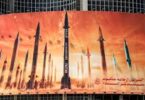Richard Goldberg / Matthew Zweig / Behnam Ben Taleblu / Saeed Ghasseminejad
Introduction
During a March 2021 appearance before the House Committee on Foreign Affairs, Secretary of State Antony Blinken pledged not to make any concessions to Iran regarding its missile program while persuading Tehran to return to compliance with the 2015 nuclear deal, formally known as the Joint Comprehensive Plan of Action (JCPOA).1 Less than one month later, however, State Department Spokesperson Ned Price refused to rule out missile-sanctions relief as an inducement for the regime to rejoin the deal.2
Offering Iran missile-sanctions relief without first addressing the Islamic Republic’s robust missile program should be alarming to Congress. The JCPOA imposes no limits on Iran’s missile development and proliferation; instead, the deal schedules UN restrictions on Iran’s ballistic missiles to expire in 2023.3 During the years the United States participated in the JCPOA (2015 to 2018), Iran launched at least 27 ballistic missiles as part of tests or military operations.4 Last year, the clerical regime fired ballistic missiles at military bases in Iraq housing American personnel.5 Iran’s terrorist proxies use Iranian-supplied ballistic and cruise missiles and unmanned aerial vehicles (UAVs) to target and harass U.S. forces and allies across the Middle East. Between all of this and Tehran’s ambitions to develop longer-range nuclear-capable ballistic missiles that could reach the United States and Europe, lifting sanctions on Iran’s missile program undermines U.S. national security interests.
Congress should send a resolute and bipartisan message to the Biden administration: Regardless of where members stand on the JCPOA, an overwhelming majority of legislators agree that no missile-sanctions relief should be provided to Iran as part of rejoining the agreement. This message would align with Blinken’s testimony and his 2020 campaign commitment to “continue non-nuclear sanctions as a strong hedge against Iranian misbehavior in other areas.”6
This memorandum summarizes the threats posed by Iran’s missile force; reviews the longstanding record of bipartisan support for missile sanctions on the Islamic Republic; and provides a detailed list of U.S. missile sanctions in place as of April 15, 2021.
Iran’s Missile Threat
Multiple U.S. intelligence assessments have reported that Iran has the largest ballistic missile arsenal in the Middle East.7 Missiles not only offer Iran a cheaper long-range strike platform compared to military aircraft – which are harder to procure, due to sanctions – but can also serve as a delivery vehicle for nuclear weapons or other weapons of mass destruction (WMD). U.S. intelligence assesses that Iran’s ballistic missiles “are inherently capable of delivering WMD.”8
Tehran’s arsenal includes both short- and medium-range ballistic missiles, which use either solid or liquid propellants. Some of these missiles can travel at least 2,000 kilometers, giving the Islamic Republic the ability to strike American bases and allied nations across the region.9 Iran also maintains several space-launch vehicles,10 thereby “shorten[ing] the timeline” for developing a potential intercontinental ballistic missile capability, according to the U.S. intelligence community.11 According to a recent report submitted to the UN Security Council, Iran has also resumed cooperation with North Korea on the development of long-range missile systems.12 Tehran has supported the missile capabilities of its partners in the region – Iraqi Shiite militias,13 the Assad regime in Syria,14 Lebanese Hezbollah,15 and the Houthi rebels in Yemen.16
For more than a decade, the Islamic Republic has been working to improve the quality of its sizable arsenal. This includes a drive for more accurate systems, the development of different warheads, and steps toward greater road-mobility and battlefield reliability.17 Greater missile precision could lead to potential changes in Iranian security policy and offensive missile operations.18 Furthermore, Iran has begun to employ – not just stockpile – its increasingly accurate missile force in publicized retaliatory operations, marking a stark shift in Tehran’s risk tolerance and deterrence capabilities.19
Iran’s cruise missile and UAV programs continue to advance as well. In 2017, drawing on evidence from recovered battlefield debris, the United States claimed that Iran proliferated drones to the Houthi rebels in Yemen to fire at Saudi Arabia,20 a phenomenon that continues into the present.21 Iran has also proliferated cruise missiles to the Houthis.22 In 2019, an Iranian land-attack cruise missile and drone strike on Saudi Arabia caused significant damage to a Saudi Aramco facility, briefly disrupting 5 percent of the world’s oil supply.23 In 2021, Iran was reportedly behind missile attacks on Israeli vessels in the Gulf of Oman and Arabian Sea.24 According to media reports, Israeli security officials worry Iran could use cruise missiles or UAVs to target Israeli territory as well.25 In March 2021, Israeli Prime Minister Benjamin Netanyahu hinted that Houthi strike capabilities had impeded a trip to the United Arab Emirates, which would have required traversing Saudi airspace.26
Congressional Support for Sanctions on Iran’s Missile Programs
Prior to the JCPOA, successive administrations and Congresses reached consensus on the importance of addressing Iran’s ballistic missile program.
The Iran Sanctions Act of 1996 (ISA), which President Bill Clinton signed into law, expanded sanctions on Iran for its malign activities, including its ballistic missile program. To lift sanctions imposed under ISA, the Islamic Republic must have, inter alia, “ceased its efforts to design, develop, manufacture, or acquire … ballistic missiles and ballistic missile launch technology.”27
Congress imposed additional sanctions on Iran’s ballistic missile capabilities when it passed the Iran, North Korea, and Syria Nonproliferation Act in 2002 and the Iran Freedom Support Act in 2006.28 In 2010, Congress again specifically tied the termination of sanctions imposed under the Comprehensive Iran Sanctions, Accountability, and Divestment Act (CISADA) to Iran’s ceasing “the pursuit, acquisition, and development of … ballistic missiles and ballistic missile launch technology.”29 Congress later based the termination criteria for sanctions against the Central Bank of Iran and many other significant provisions on this same CISADA standard.30 In 2012, President Barack Obama signed into law the Iran Threat Reduction and Syria Human Rights Act and strengthened the termination criteria in CISADA, requiring that Iran verifiably dismantle its ballistic missile programs and capabilities.31
In 2015, as the Obama administration pressed Congress to support the JCPOA, the White House declared that although it was lifting sanctions up front to enter the nuclear deal, “[a]uthorities will remain in place to allow the U.S. government to target Iran’s development of missiles and other means to deliver weapons of mass destruction.”32 In 2017, while the United States remained a participant in the JCPOA, the U.S. Senate voted 98-2 to impose sanctions on any entity that “materially contributes to: (1) Iran’s ballistic missile or weapons of mass destruction programs, or (2) the sale or transfer to Iran of specified military equipment or the provision of related technical or financial assistance.” These sanctions became law as part of the Countering America’s Adversaries Through Sanctions Act (CAATSA), which passed the House and Senate nearly unanimously.33
The State and Treasury departments typically impose missile-related sanctions on Iran pursuant to Executive Order (E.O.) 13382, which allows the president to block the assets of proliferators of weapons of mass destruction and their supporters.34 Since E.O. 13382 is also typically used to impose sanctions on Iran’s nuclear program, the Biden administration may attempt to broadly lift E.O. 13382 sanctions on Iran and call them all “nuclear sanctions.” To help prevent this, the last section of this memorandum provides a list of E.O. 13382 sanctions imposed on Iran specifically for its missile-related activities.
Perhaps most importantly, Iran’s Islamic Revolutionary Guard Corps (IRGC) was designated in 2007 under E.O. 13382 for its key role in Iran’s ballistic missile and nuclear programs.35 Thus, many sanctions imposed on the IRGC and its affiliates are not just terrorism sanctions but missile sanctions as well.
Sectors of Iran’s Economy Connected to Missile Development36
The development of ballistic missiles relies on a variety of industries to procure materials and provide expertise, including the automotive, construction, electronics and telecommunications, mining and industrial metals, and petrochemicals and energy sectors.37 Providing these sectors sanctions relief of any form – including rescinding executive orders, rescinding sector designations made pursuant to executive orders, or issuing national security waivers pursuant to various Iran sanctions laws – would benefit Iran’s missile programs.
Automotive Sector: Iran’s ballistic missile program needs the automotive sector to produce vehicles to carry, erect, and launch38 The U.S. Treasury Department sanctioned Iran’s automotive sector pursuant to E.O. 13846 in 2018.39
Construction Sector: The construction sector creates testing and production facilities, above-ground and underground storage areas, and bases and launch facilities for the missile program. Over the last few years, the IRGC has unveiled several underground missile depots. Such depots insulate Iran’s most prized weapon – ballistic missiles – from discovery and destruction by enemy forces, while affording the regime an option for a surprise attack.40 Furthermore, Iranian media have revealed that Tehran has an operational underground missile production facility. The IRGC presence in the construction sector is significant. Khatam al-Anbia, the construction arm of the IRGC, is the sector’s biggest contractor and has been involved in large construction projects both in Iran and abroad.41 The U.S. government sanctioned Iran’s construction sector in 2020 pursuant to O. 13902.42
Electronics and Telecommunications Sectors: The electronics and telecommunications sectors are involved in ballistic missile testing and production and in missile-control systems.43 For years, the IRGC, in partnership with the supreme leader’s business empire, was the largest shareholder of Iran’s biggest communications service providers, the Telecommunication Company of Iran and the Mobile Communication Company of Iran.44 While the United States has not designated Iran’s electronics and telecommunications sectors, the U.S Treasury Department has designated entities in these sectors, such as Iran Electronics Industries, Iran Communication Industries, and Information Systems of Iran, for their roles in Iran’s ballistic missile program.45
Mining and Industrial Metals Sectors: Iran’s mining and industrial metals sectors supply raw and processed materials for military uses, including ballistic missile production. For example, Iran has large reserves of zinc and copper, used for treatments that reduce the visibility of missiles to prevent detection and interception.46 Iran also produces zirconium products for its ballistic missile program.47 The IRGC is active in the mining and industrial metals sectors. Reportedly, the IRGC has helped Iran produce aluminum powder, which can be used to develop solid propellant.48 Similarly, the IRGC controls extraction and production of zinc as the majority shareholder of the Iran Zinc Mines Development Company.49 Iran’s mining and industrial metals sectors are subject to sanctions pursuant to E.O. 13871 and E.O. 13902.50
Petrochemical and Energy Sectors: The petrochemical and energy sectors provide the explosive systems, fuel materials, and composite materials needed for Iran’s ballistic missile program.51 Iran’s Ministry of Defense and Armed Forces Logistics and the IRGC, two entities that historically have been the driving forces behind the development and deployment of Iran’s ballistic missiles, use companies in the petrochemical and energy sectors to produce or procure what the missile program needs.52 The U.S. Treasury Department has designated Iran’s petrochemical and energy sectors and a vast network of firms and individuals active in these sectors.53 Iran’s energy sector is the most heavily sanctioned sector in the country, through the Iran Sanctions Act, Section 1245 of the National Defense Authorization Act for Fiscal Year 2012, the Iran Threat Reduction and Syria Human Rights Act, the Iran Freedom and Counterproliferation Act, and E.O. 13846.54
Missile Sanctions Against Iran
As of April 15, 2021, more than 250 Iran-connected companies, institutions, and individuals were sanctioned for their connection to the Islamic Republic’s missile program. Sanctions relief of any form that provides benefits to these entities and individuals – including removing them from the Specially Designated Nationals and Blocked Persons List, granting general licenses, or issuing national security waivers pursuant to various Iran sanctions laws – would directly undermine U.S. interests.
Courtesy: (FDD)






